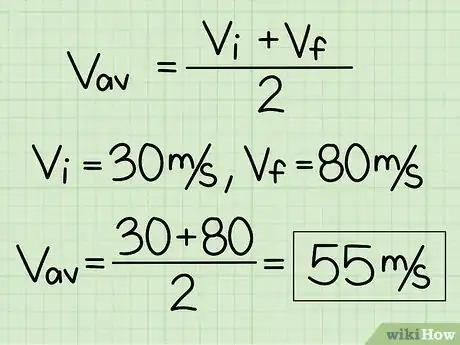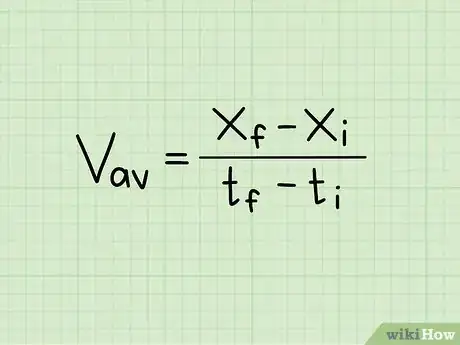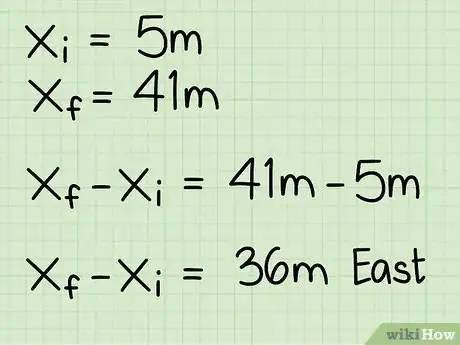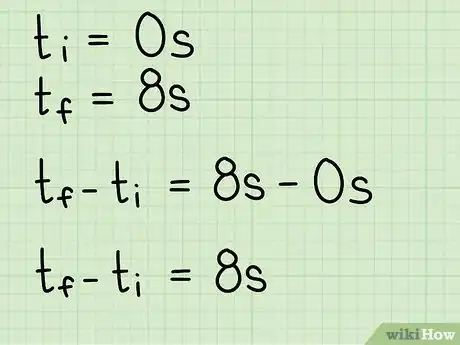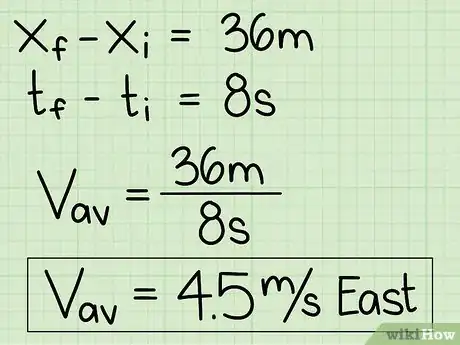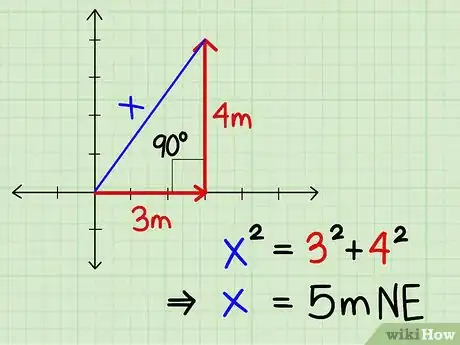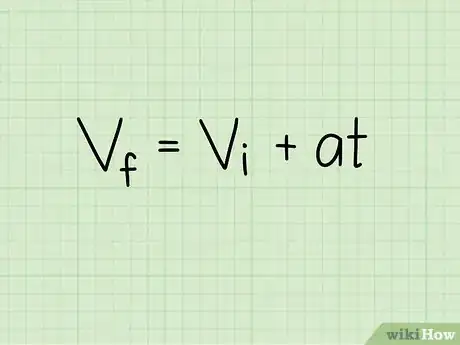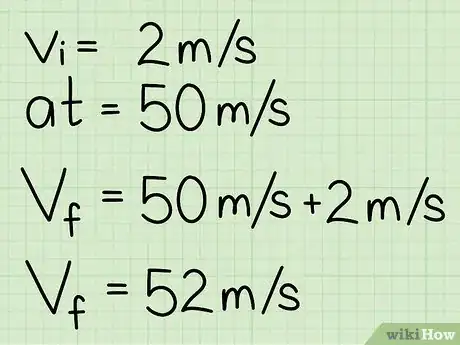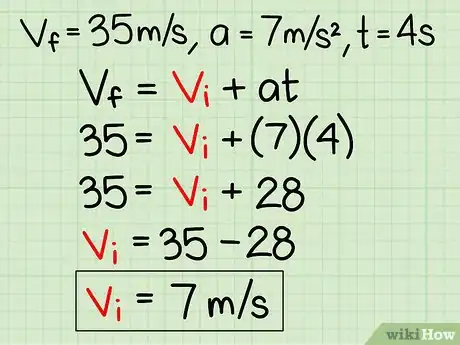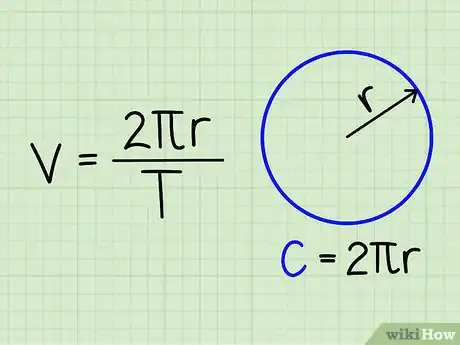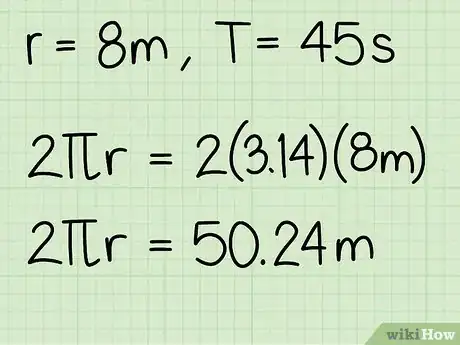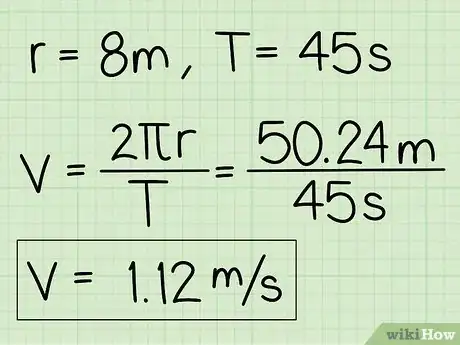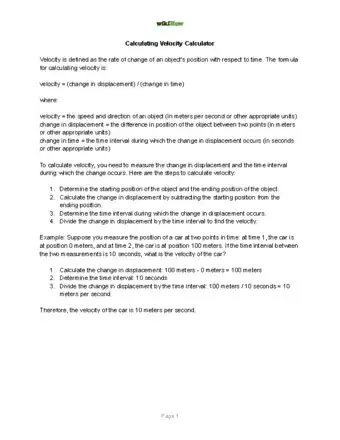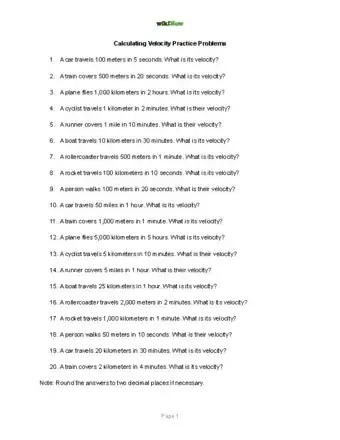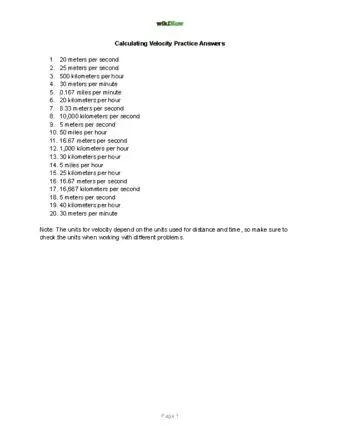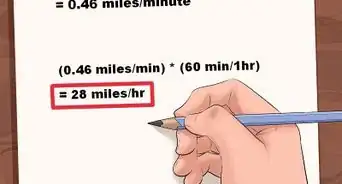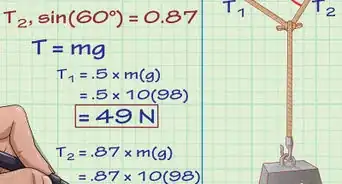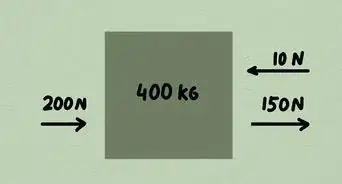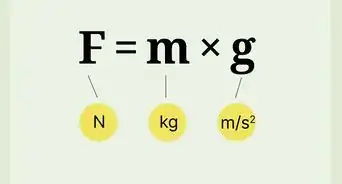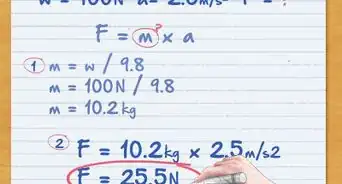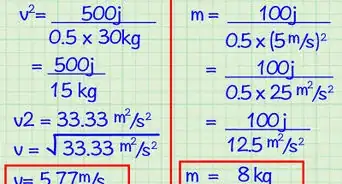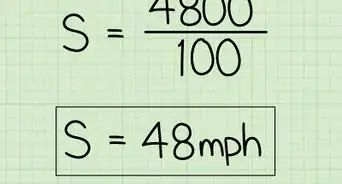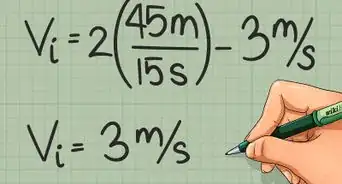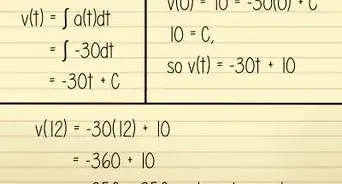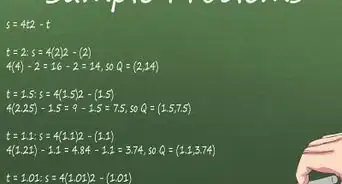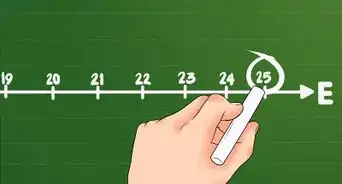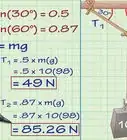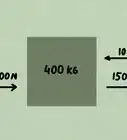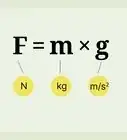This article was co-authored by Sean Alexander, MS. Sean Alexander is an Academic Tutor specializing in teaching mathematics and physics. Sean is the Owner of Alexander Tutoring, an academic tutoring business that provides personalized studying sessions focused on mathematics and physics. With over 15 years of experience, Sean has worked as a physics and math instructor and tutor for Stanford University, San Francisco State University, and Stanbridge Academy. He holds a BS in Physics from the University of California, Santa Barbara and an MS in Theoretical Physics from San Francisco State University.
There are 10 references cited in this article, which can be found at the bottom of the page.
This article has been viewed 1,413,427 times.
Velocity is an object's speed in a particular direction. Mathematically, velocity is often described as the change in position over the change in time.[1] [2] This fundamental concept shows up in many basic physics problems. Which formula you use depends on what you know about the object, so read carefully to make sure you've chosen the right one.
Quick Formulas
- Average velocity =
- final position initial position
- final time initial time
- Average velocity if acceleration is constant =
- initial velocity final velocity
- Average velocity if acceleration is zero and constant =
- Final velocity =
- a = acceleration t = time
Steps
Finding Average Velocity
-
1Find average velocity when acceleration is constant. If an object is accelerating at a constant rate, the formula for average velocity is simple:[3] . In this equation is the initial velocity, and is the final velocity. Remember, you can only use this equation if there is no change in acceleration.
- As a quick example, let's say a train accelerates at a constant rate from 30 m/s to 80 m/s. The average velocity of the train during this time is .
-
2Set up an equation with position and time instead. You can also find the velocity from the object's change in position and time. This works for any problem. Note that, unless the object is moving at a constant velocity, your answer will be the average velocity during the movement, not the specific velocity at a certain time.[4]
- The formula for this problem is , or "final position - initial position divided by final time - initial time." You can also write this as = Δx / Δt, or "change in position over change in time."
Advertisement -
3Find the distance between the start and end points. When measuring velocity, the only positions that matter are where the object started, and where the object ended up. This, along with which direction the object traveled, tells you the displacement, or change in position.[5] The path the object took between these two points does not matter.
-
Example 1: A car traveling due east starts at position x = 5 meters. After 8 seconds, the car is at position x = 41 meters. What was the car's displacement?
- The car was displaced by (41m - 5m) = 36 meters east.
-
Example 2: A diver leaps 1 meter straight up off a diving board, then falls downward for 5 meters before hitting the water. What is the diver's displacement?
- The diver ended up 4 meters below the starting point, so her displacement is 4 meters downward, or -4 meters. (0 + 1 - 5 = -4). Even though the diver traveled six meters (one up, then five down), what matters is that the end point is four meters below the start point.
-
Example 1: A car traveling due east starts at position x = 5 meters. After 8 seconds, the car is at position x = 41 meters. What was the car's displacement?
-
4Calculate the change in time. How long did the object take to reach the end point? Many problems will tell you this directly. If it does not, subtract the start time from the end time to find out.[6]
- Example 1 (cont.): The problem tells us that the car took 8 seconds to go from the start point to the end point, so this is the change in time.
- Example 2 (cont.): If the diver jumped at t = 7 seconds and hits the water at t = 8 seconds, the change in time = 8s - 7s = 1 second.
-
5Divide the total displacement by the total time. In order to find the velocity of the moving object, you will need to divide the change in position by the change in time. Specify the direction moved, and you have the average velocity.[7]
- Example 1 (cont.): The car changed its position by 36 meters over 8 seconds. 4.5 m/s east.
- Example 2 (cont): The diver changed her position by -4 meters over 1 second. -4 m/s. (In one dimension, negative numbers are usually used to mean "down" or "left." You could say "4 m/s downward" instead.)
-
6Solve problems in two dimensions. Not all word problems involve movement back along one line. If the object turns at some point, you may need to draw a diagram and solve a geometry problem to find the distance.
-
Example 3: A man jogs for 3 meters east, then make a 90º turn and travels 4 meters north. What is his displacement?
- Draw a diagram and connect the start point and end point with a straight line. This is the hypotenuse of a triangle, so solve for its length of this line using properties of right triangles. In this case, the displacement is 5 meters northeast.
- At some point, your math teacher may require you to find the exact direction traveled (the angle above the horizontal). You can do this by using geometry or by adding vectors.
-
Example 3: A man jogs for 3 meters east, then make a 90º turn and travels 4 meters north. What is his displacement?
Finding Velocity from Acceleration
-
1Understand the velocity formula for an accelerating object. Acceleration is the change in velocity. If the acceleration is constant, the velocity continues to change at the same rate.[8] We can describe this by multiplying acceleration and time, and adding the result to the initial velocity:
- , or "final velocity = initial velocity + (acceleration * time)"
- Initial velocity is sometimes written as ("velocity at time 0").
-
2Multiply the acceleration by the change in time. This will tell you how much the velocity increased (or decreased) over this time period.[9]
-
Example: A ship sailing north at 2 m/s accelerates north at a rate of 10 m/s2. How much did the ship's velocity increase in the next 5 seconds?
- a = 10 m/s2
- t = 5 s
- (a * t) = (10 m/s2 * 5 s) = 50 m/s increase in velocity.
-
Example: A ship sailing north at 2 m/s accelerates north at a rate of 10 m/s2. How much did the ship's velocity increase in the next 5 seconds?
-
3Add the initial velocity. Now you know the total change in the velocity. Add this to the initial velocity of the object, and you have your answer.[10]
-
Example (cont): In this example, how fast is the ship traveling after 5 seconds?
-
Example (cont): In this example, how fast is the ship traveling after 5 seconds?
-
4Specify the direction of movement. Unlike speed, velocity always includes the direction of movement. Make sure to include this in your answer.
- In our example, since the ship started going north and did not change direction, its final velocity is 52 m/s north.
-
5Solve related problems. As long as you know the acceleration, and the velocity at any one point in time, you can use this formula to find the velocity at any other time. Here's an example solving for the initial velocity:
- "A train accelerates at 7 m/s2 for 4 seconds, and ends up traveling forward at a velocity of 35 m/s. What was its initial velocity?"
-
- "A train accelerates at 7 m/s2 for 4 seconds, and ends up traveling forward at a velocity of 35 m/s. What was its initial velocity?"
Circular Velocity
-
1Learn the formula for circular velocity. Circular velocity refers to the velocity that one object must travel in order to maintain its circular orbit around another object, usually a planet or other gravitating mass.[11]
- The circular velocity of an object is calculated by dividing the circumference of the circular path by the time period over which the object travels.
- When written as a formula, the equation is:
- v = (2πr) / T
- Note that 2πr equals the circumference of the circular path.
- r stands for "radius"
- T stands for "time period"
-
2Multiply the circular radius by 2π. The first stage of the problem is calculating the circumference. To do this, multiply the radius by 2π. If you are calculating this by hand, you can use 3.14 as an approximation for π.[12]
- Example: Find the circular velocity of an object traveling a circular path with a radius of 8 m over a full time interval of 45 seconds.
- r = 8 m
- T = 45 s
- Circumference = 2πr = ~ (2)(3.14)(8 m) = 50.24 m
- Example: Find the circular velocity of an object traveling a circular path with a radius of 8 m over a full time interval of 45 seconds.
-
3Divide this product by the time period. In order to find the circular velocity of the object in question, you need to divide the calculated circumference by the time period over which the object traveled.[13]
- Example: v = (2πr) / T = 50.24 m / 45 s = 1.12 m/s
- The circular velocity of the object is 1.12 m/s.
- Example: v = (2πr) / T = 50.24 m / 45 s = 1.12 m/s
Calculator, Practice Problems, and Answers
Community Q&A
-
QuestionWhen do we have deceleration?
 Benjamin WalkerCommunity AnswerAs the object loses energy passing through a medium. The medium an object is passing through will determine the deceleration.
Benjamin WalkerCommunity AnswerAs the object loses energy passing through a medium. The medium an object is passing through will determine the deceleration. -
QuestionHow do I calculate the velocity of something given its time traveled and distance covered?
 Community AnswerDivide distance traveled by the time taken to get the average speed. Velocity is the term used for speed when the object travels in a uniform direction (i.e. straight line or circle).
Community AnswerDivide distance traveled by the time taken to get the average speed. Velocity is the term used for speed when the object travels in a uniform direction (i.e. straight line or circle). -
QuestionHow does velocity change if the distance decreases and the time increases?
 Community AnswerVelocity decreases. Think about it: It takes a longer time to cover a shorter distance.
Community AnswerVelocity decreases. Think about it: It takes a longer time to cover a shorter distance.
References
- ↑ Sean Alexander, MS. Academic Tutor. Expert Interview. 14 May 2020.
- ↑ https://www.khanacademy.org/science/physics/one-dimensional-motion/displacement-velocity-time/a/what-is-velocity
- ↑ https://www.physicsclassroom.com/class/1DKin/Lesson-1/Speed-and-Velocity
- ↑ https://openstax.org/books/university-physics-volume-1/pages/3-1-position-displacement-and-average-velocity
- ↑ http://www.physicsclassroom.com/Class/1DKin/U1L1c.cfm
- ↑ https://openstax.org/books/university-physics-volume-1/pages/3-1-position-displacement-and-average-velocity
- ↑ https://openstax.org/books/university-physics-volume-1/pages/3-1-position-displacement-and-average-velocity
- ↑ Sean Alexander, MS. Academic Tutor. Expert Interview. 14 May 2020.
- ↑ https://www.omnicalculator.com/physics/velocity
- ↑ https://www.omnicalculator.com/physics/velocity
- ↑ http://easycalculation.com/physics/classical-physics/circular-velocity.php
- ↑ https://www.omnicalculator.com/physics/angular-velocity
- ↑ https://math.libretexts.org/Bookshelves/Precalculus/Book%3A_Trigonometry_(Sundstrom_and_Schlicker)/01%3A_The_Trigonometric_Functions/1.04%3A_Velocity_and_Angular_Velocity
- ↑ https://physics.info/velocity/
- ↑ Sean Alexander, MS. Academic Tutor. Expert Interview. 14 May 2020.
About This Article
Velocity is defined as the speed at which an object travels in a given direction. The right formula to use for calculating velocity depends on a few different factors, such as whether the object is accelerating at a constant rate, or whether it is moving in a circle as opposed to a line. The most basic formula for calculating velocity is velocity (v) = distance (d)/time (t). If you don’t already know the time and distance, you’ll need to calculate them first. Subtract the initial position from the final position to find distance, and subtract the start time from the end time to find the time. For instance, if a runner began sprinting due east at the 22-meter mark along a track and ended up at the 52-meter mark, you’d subtract 22 from 52 to find the distance, or displacement, of 30 meters. Similarly, if they began their sprint at 5:35:01 pm and ended it at 5:35:06 pm, you can find the time by subtracting 1 from 6, giving you 5 seconds. This will tell you that they ran 30 meters in 5 seconds, which means that they maintained an average velocity of 6 m/s east. If you’re finding the velocity of an object that’s accelerating instead of moving at a constant rate, things get a little more complicated. If you know the acceleration rate of the object, you can find the final velocity using the formula vf (final velocity) = vi (initial velocity) + a(t) (acceleration x time). For example, if an object accelerated north at a rate of 5m/s2 over 5 seconds and had a starting velocity of 6 m/s, its final velocity would be 6m/s + (5m/s2 x 5s), or 31m/s north. Once you know both the final and initial velocity, you can calculate the average velocity of an accelerating object. To do this, add initial velocity to final velocity and divide the result by 2. In this case, 6m/s + 30m/s divided by 2 = 18 m/s north. The method for finding the velocity of an object around a circle is a little different. To do this, use the formula v (velocity) = 2πr (the circumference of the circle)/t (time). For example, an object that moves around a circle with a radius of 50 meters in 13 seconds would have a velocity of 2π(50)m/13s, or approximately 24.17 m/s. To learn more, such as how to calculate average or circular velocity, keep reading the article!











